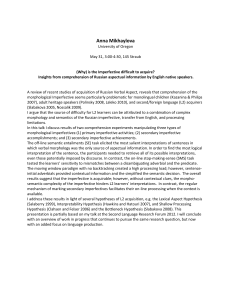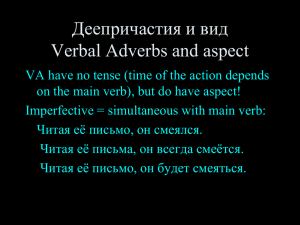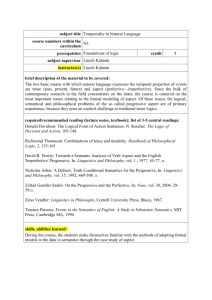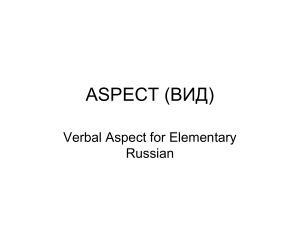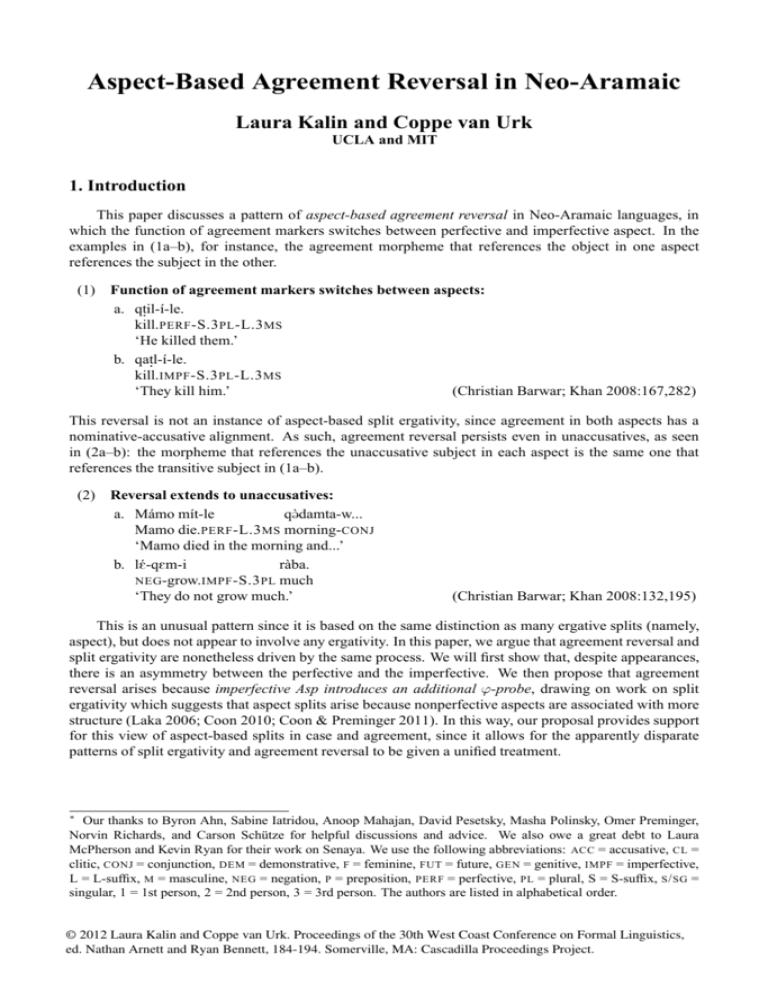
Aspect-Based Agreement Reversal in Neo-Aramaic
Laura Kalin and Coppe van Urk
UCLA and MIT
1. Introduction
This paper discusses a pattern of aspect-based agreement reversal in Neo-Aramaic languages, in
which the function of agreement markers switches between perfective and imperfective aspect. In the
examples in (1a–b), for instance, the agreement morpheme that references the object in one aspect
references the subject in the other.
(1) Function of agreement markers switches between aspects:
a. qtil-ı́-le.
˙ PERF -S.3 PL -L.3 MS
kill.
‘He killed them.’
b. qatl-ı́-le.
˙ IMPF -S.3 PL -L.3 MS
kill.
‘They kill him.’
(Christian Barwar; Khan 2008:167,282)
This reversal is not an instance of aspect-based split ergativity, since agreement in both aspects has a
nominative-accusative alignment. As such, agreement reversal persists even in unaccusatives, as seen
in (2a–b): the morpheme that references the unaccusative subject in each aspect is the same one that
references the transitive subject in (1a–b).
(2) Reversal extends to unaccusatives:
q`@damta-w...
a. Mámo mı́t-le
Mamo die.PERF -L.3 MS morning-CONJ
‘Mamo died in the morning and...’
ràba.
b. lÉ-qEm-i
NEG -grow. IMPF -S.3 PL much
‘They do not grow much.’
(Christian Barwar; Khan 2008:132,195)
This is an unusual pattern since it is based on the same distinction as many ergative splits (namely,
aspect), but does not appear to involve any ergativity. In this paper, we argue that agreement reversal and
split ergativity are nonetheless driven by the same process. We will first show that, despite appearances,
there is an asymmetry between the perfective and the imperfective. We then propose that agreement
reversal arises because imperfective Asp introduces an additional ϕ-probe, drawing on work on split
ergativity which suggests that aspect splits arise because nonperfective aspects are associated with more
structure (Laka 2006; Coon 2010; Coon & Preminger 2011). In this way, our proposal provides support
for this view of aspect-based splits in case and agreement, since it allows for the apparently disparate
patterns of split ergativity and agreement reversal to be given a unified treatment.
∗
Our thanks to Byron Ahn, Sabine Iatridou, Anoop Mahajan, David Pesetsky, Masha Polinsky, Omer Preminger,
Norvin Richards, and Carson Schütze for helpful discussions and advice. We also owe a great debt to Laura
McPherson and Kevin Ryan for their work on Senaya. We use the following abbreviations: ACC = accusative, CL =
clitic, CONJ = conjunction, DEM = demonstrative, F = feminine, FUT = future, GEN = genitive, IMPF = imperfective,
L = L-suffix, M = masculine, NEG = negation, P = preposition, PERF = perfective, PL = plural, S = S-suffix, S / SG =
singular, 1 = 1st person, 2 = 2nd person, 3 = 3rd person. The authors are listed in alphabetical order.
© 2012 Laura Kalin and Coppe van Urk. Proceedings of the 30th West Coast Conference on Formal Linguistics,
ed. Nathan Arnett and Ryan Bennett, 184-194. Somerville, MA: Cascadilla Proceedings Project.
185
The paper is organized as follows. Section 2 introduces the pattern of agreement reversal. Section
3 discusses the implications of the PCC effect found in the perfective and outlines the basics of our
proposal. Section 4 outlines how the presence of an additional ϕ-probe on imperfective Asp can
derive the pattern of agreement reversal, and presents evidence for this account from the behavior of
ditransitives and from another unusual aspect split in Senaya. Finally, section 5 shows that our account
ties in naturally with recent work on split ergativity (Laka 2006; Coon 2010; Coon & Preminger 2011)
and the idea that nonperfective aspects include additional prepositional structure (Demirdache & UribeEtxebarria 2000; Coon 2010).
2. The pattern of agreement reversal
Many of the northeastern Neo-Aramaic languages have adopted aspect-based splits in agreement,
apparently as a result of contact with various split ergative Kurdish languages (Doron & Khan 2012). In
a number of Neo-Aramaic languages, this aspect split takes on an unusual form, in that no ergativity
appears to be involved. Instead, both sides of the split have a nominative-accusative alignment in
agreement, but the subject marking of one aspect is the object marking of the other.
We call this pattern agreement reversal and it surfaces in Christian Barwar, Christian Qaraqosh, and
related varieties (Khan 2002, 2008; Coghill 2003; Doron & Khan 2012).1 We focus on Christian Barwar
and Christian Qaraqosh here, because these are the most well-documented (Khan 2002, 2008).
Agreement reversal manifests itself in the morphology that attaches to the verb. The Neo-Aramaic
languages we discuss here all make use of the verbal template in (3), where the terms S-suffix and L-suffix
refer to different sets of agreement markers.2
(3) Verbal template in Neo-Aramaic:
Verb stem - S-suffix - L-suffix
The paradigms for these morphemes in Christian Barwar, from Khan (2008), are in Tables 1 and 2.
Table 1: S-suffixes in Barwar
Singular
Plural
1st person
-@n
-@x
2nd person
-@t
-itu
3rd person -∅ (m.)/-a (f.)
-i
Table 2: L-suffixes in Barwar
Singular
1st person
-li
2nd person -lux (m.)/-l@x (f.)
3rd person
-le (m.)/-la (f.)
Plural
-l@n
-lÉxi
-lE/-la
An important fact about these paradigms, which holds in all agreement reversal languages, is that the
default S-suffix (3rd person masculine singular) has a null spell-out. This will be important in our
analysis, as we will propose that the probe behind S-suffixes is present in some derivations but fails to
register agreement and so spells out as default, which is null.
The agreement markers in Tables 1 and 2 combine with a number of different verbal bases, which
are formed by means of root-and-pattern morphology. We will be concerned with the imperfective and
perfective bases. Some examples of these in Barwar are given in Table 3.
Table 3: Barwar verbal bases
Root
Imperfective base
pθx (‘to open’)
paθ@x
m-šlx (‘to strip’)
mšal@x
m-plx (‘to use’)
mapl@x
1
Perfective base
pθix
mšol@x
mupl@x
Doron and Khan (2012) treat agreement reversal as an case of split ergativity involving extended ergativity (i.e. a
system in which ergative generalizes to unaccusatives) in the perfective. We do not have the space to discuss their
proposal here, though we note that the existence of such ergative systems is controversial and that their account does
not provide a principled explanation of the directionality of the agreement asymmetries behind agreement reversal.
2
Although we adopt this terminology from Khan (2002, 2008), the term L-suffix is a misnomer, as we will argue
that the L-suffixes are clitics, following Doron and Khan (2012). This is motivated, for instance, by the fact that
L-suffixes, but not S-suffixes, can appear outside of other enclitic material, specifically the enclitic auxiliary.
186
Both of these bases take S-suffixes and L-suffixes in accordance with the verbal template in (3).
The functions of these agreement markers reverse between aspects, however. When attached to the
imperfective base, the S-suffix marks subject agreement and the L-suffix marks agreement with a definite
or pronominal object. The examples in (4a–c), again from Christian Barwar, illustrate.
(4)
I MPERFECTIVE S-suffix = subject, L-suffix = object:
a. mEy-´@n-na
’ay-bàxta.
bring.IMPF -S.1 SG-L.3 FS DEM-woman
‘I shall bring that woman.’
b. xošéba lá-palx-i
nàše.
Sunday NEG-work.IMPF -S.3 PL people
‘On Sunday, people do not work.’
c. ’ána mÉθ-en
’as@` rta.
˙
I
die.IMPF -S.1 SG evening
‘I shall die in the evening.’
(Christian Barwar; Khan 2008:115,132,135)
The subject of a transitive, unergative, and unaccusative all pattern alike (marked with S-suffixes), while
objects are treated uniquely (marked with L-suffixes).
With the perfective base, however, L-suffixes no longer mark objects, but cross-reference the subject,
even in an unaccusative. S-suffixes now function as object markers, and so only appear in transitives.3
(5)
P ERFECTIVE S-suffix = object, L-suffix = subject:
griš-a-la.
a. xawr-ăwaθ-i brat-i
friend-PL-1 SG daughter-1 SG pull.PERF-S.3 FS-L.3 PL
‘My friends pulled my daughter.’
b. kalba nwix-le.
dog bark.PERF -L.3 MS
‘The dog barked.’
qim-la.
c. brat-i
daughter-1 SG rise.PERF-L.3 FS
‘My daughter rose.’
(Christian Barwar; Doron & Khan 2012:231)
We will refer to this pattern as agreement reversal. It can be schematized as in (6).
(6)
Verbal base
Imperfective
Perfective
-
S-suffix
SubjAgr
ObjAgr
-
L-suffix
ObjAgr
SubjAgr
This aspect split is quite unusual. It is reminiscent of split ergativity, since it shows up in a place typical
of ergative splits, namely between the perfective and imperfective (e.g. Hindi and Chol). However, both
sides of the aspect split have a fully nominative-accusative alignment, so that there is no real ergativity
anywhere in the system.
3. The perfective and the PCC
We will start by developing our account of the perfective, which we take to have the most basic
syntax. We argue that, despite appearances, there is only one ϕ-probe in the perfective, which has
3
Just like object agreement in the imperfective, this agreement is subject to a definiteness restriction. We will not
to be too concerned with this here, though there are at least two accounts of this that are fully compatible with our
theory of agreement reversal. One option is to say that indefinite objects undergo pseudo-incorporation, in the sense
of Massam (2001) and Dayal (2011), so that they are inaccessible for agreement. Another option is that definite
objects raise to the edge of a lower phase (e.g. VP), following the treatment of Sakha differential object marking in
Baker and Vinokurova (2010). This movement step would make definite objects, but not indefinite objects, visible
for agreement. The former approach is adopted for the Senaya facts in (22a–b) in Kalin and van Urk (to appear).
187
to license both the subject and the object. This probe clitic-doubles the subject, while registering true
agreement with the object, creating the appearance of two separate agreement morphemes. The empirical
motivation for this proposal comes from the existence of a Strong PCC effect between the subject and
the object in the perfective, and our syntax for the perfective mirrors the Béjar and Rezac (2003) theory
of this phenomenon.
3.1. The Person Case Constraint
The P ERSON C ASE C ONSTRAINT (PCC) refers to the ungrammaticality of certain combinations of
person when two arguments occupy the same domain (Bonet 1991). We will be concerned here with
the Strong PCC, which restricts the lower argument to 3rd person. In Greek ditransitives, for instance, a
direct object clitic in the context of an indirect object has to be 3rd person:
(7) Direct object clitic of Greek ditransitives has to be 3rd person:
to
stilune.
a. Tha tu
FUT CL . GEN .3 SG CL . ACC .3 SG send-3 PL
‘They will send it to him.’
se
stilune.
b. *Tha tu
FUT CL . GEN .3 SG CL . ACC .2 SG send-3 PL
‘They will send you to him.’
(Greek; based on Anagnostopoulou 2005)
We can state the Strong PCC as follows:
(8) Strong PCC (Bonet 1991):
For two arguments in a domain X, the lower argument has to be third person.
In the agreement reversal languages, a Strong PCC effect obtains between the subject and object of the
perfective, such that the object has to be 3rd person:4
(9) Barwar object has to be 3rd person in the perfective:
a. *griš-an-le.
pull.PERF -S.1 FS -L.3 MS
‘He pulled me.’
b. *griš-at-le.
pull.PERF -S.2 FS -L.3 MS
‘He pulled you.’
c. griš-ı́-le.
pull.PERF -S.3 PL -L.3 MS
‘He pulled them.’
(Christian Barwar; Doron & Khan 2012:232)
Most accounts of the PCC assume that PCC effects arise when two arguments compete for the
attention of one ϕ-probe (e.g. Anagnostopoulou 2003; Béjar & Rezac 2003; Nevins 2007; Rezac 2011).5
As such, we take the existence of a PCC effect to suggest that there is only one ϕ-probe in the perfective
of agreement reversal languages, which has to license both the subject and the object.
To be precise, we adopt the Béjar and Rezac (2003) account of the Strong PCC. Béjar and Rezac
propose that a ϕ-probe can sometimes agree with multiple arguments because ϕ-probes consist of
separate person (π) and number (#) probes, which probe independently. These probes can end up
targeting different DPs if the one that probes first, which Béjar and Rezac assume is the person probe,
triggers a change in the DP it agrees with. For Béjar and Rezac, this change is clitic-doubling of the
4
In order to express a 1st or 2nd person object with the perfective, these languages make use of two strategies. The
object can be embedded under a preposition, in which case all persons are acceptable, or the perfective is expressed
periphrastically, by putting a perfective prefix on the imperfective base (agreement is just as in the imperfective).
5
Note that the syntactic signature of the PCC means that a morphological analysis of agreement reversal, as
suggested by Baerman (2007) for Hertevin, is not appropriate for Barwar. For detailed argumentation that the
PCC is syntactic, see Rezac (2011).
188
goal DP, which they assume makes arguments invisible for further probing.6 If the person probe is a
clitic-doubler, the highest argument becomes inaccessible to further probing. The number probe will
then end up targeting a different DP. In this way, one ϕ-probe can agree with multiple arguments.
The tree in (10) represents this situation. Person probes first and agrees with DP1 . As part of this
Agree relation, the person probe clitic-doubles DP1 , so that DP1 becomes invisible for further probing.
Number then probes, ignoring DP1 , and agrees with DP2 .
(10)
π, #
CL
DP1
X
DP2
Béjar and Rezac propose that the Strong PCC effect emerges in this environment. Specifically, they
argue that the Strong PCC effect arises because 1st and 2nd person DPs are special in that they require
person agreement to be licensed. They call this licensing requirement the PLC, stated as follows:
(11) Person Licensing Condition (PLC; Béjar & Rezac 2003):
Interpretable 1st/2nd-person features must be licensed by entering into an Agree relation with an
appropriate functional category.
The PLC means that, in the situation in (10), only the higher argument can be 1st or 2nd person, since
only the higher argument, DP1 , enters into person agreement. In contrast, the lower argument in (10)
DP2 , only agrees with a number probe and so will violate the PLC if 1st or 2nd person.
The PLC is a licensing requirement that is independent of case. Béjar and Rezac assume that
agreement with any ϕ-probe, whether it is a person or number probe, suffices for case assignment. As
such, a 3rd person DP in the lower position in (10) is case-licensed by virtue of agreeing with a number
probe. And, since a 3rd person DP is not subject to the PLC, it does not need to agree with a person
probe to be licensed. In this way, the lower argument is restricted to 3rd person and the Strong PCC
effect is derived.
3.2. Agreement in the perfective
To derive the Strong PCC effect in agreement reversal languages, we implement the Béjar and Rezac
(2003) account. We will treat the perfective in agreement reversal languages as an environment in which
one ϕ-probe agrees with multiple arguments. In particular, we propose that Christian Barwar and related
languages differ from other nominative-accusative languages in that T carries a ϕ-probe, but not v, so
that v is inactive.7 As a result, there is no head that is dedicated to licensing objects; thus, in transitives,
both the subject and the object have to be licensed by T.
To be precise, we propose that the person probe on T in agreement reversal languages is a cliticdoubler, which clitic-doubles the DP it agrees with. The reflex of this relation is an L-suffix, which
we take to be a clitic, following Doron and Khan (2012; see also fn. 2). In the perfective, intransitive
and transitive subjects are then referenced by L-suffixes, because they are the highest argument and
therefore the argument that the person probe on T agrees with and clitic-doubles. The number probe on
T subsequently agrees with an object, if one is present. We propose that this agreement is spelled out by
6
We can see that cliticization makes DPs invisible for probing in languages like Greek and Basque, in which
clitic-doubled arguments do not count for intervention. One way of theoretically implementing this observation is
proposed by Anagnostopoulou (2003), who says that the tail of a clitic-doubling chain is an A’-trace and the head
of the chain is no longer a phrase, but a head.
7
It has to be T that is active and not v, because this would not map straightforwardly onto a PCC configuration.
Specifically, if the ϕ-probe were on v, then we would have to make an additional stipulation about the directionality
of probing (upwards then downwards) in order to account for the fact that the PCC affects objects and not subjects.
In addition, while the perfective could be accounted for this with this stipulation, it does not allow imperfective Asp
to interfere in the desired way in the imperfective, as is needed to derive agreement reversal; see §4.1.
189
an S-suffix, which marks true agreement. These assumptions implement the Béjar and Rezac account
and so derive the profile of agreement in the perfective.
To see exactly how this works, we will run through the derivations of perfective transitives and
intransitives. Consider first an example of a perfective transitive (12), in which an L-suffix marks the
subject and an S-suffix the object. This has the syntax in (13).
(12)
P ERFECTIVE T RANSITIVE S-suffix = object, L-suffix = subject:
griš-a-la.
xawr-ăwaθ-i brat-i
friend-PL-1 SG daughter-1 SG pull.PERF-S.3 FS -L.3 PL
‘My friends pulled my daughter.’
(Christian Barwar; Doron & Khan 2012:231)
(13)
TP
T
π, #
AspP
CL
AspPERF
vP
Subj
v
VP
V
Obj
In this derivation, person on T probes first, licensing the subject, and triggering clitic doubling. This
clitic doubling spells out as an L-suffix, since L-suffixes are the clitic series. Number on T now probes. It
ignores the subject because the subject is clitic-doubled (see fn. 6), and agrees with the object, licensing
it as well. Number agreement with the object is spelled out as an S-suffix. This derives the PCC effect,
since the perfective transitive maps exactly onto the Béjar and Rezac (2003) configuration in (10). The
object of the perfective only agrees for number, and so violates the PLC if 1st or 2nd person.
This account extends to perfective intransitives, like (14), which have the structure in (15).
(14)
P ERFECTIVE I NTRANSITIVE L-suffix = subject:
brat-i
qim-la.
daughter-1 SG rise.PERF-L.3 FS
‘My daughter rose.’
(Christian Barwar; Doron & Khan 2012:231)
(15)
TP
T
π, #
CL
AspP
AspPERF
vP
v
VP
V
Subj
In this structure, person on T probes the subject and triggers clitic doubling (because π indiscriminately
clitic-doubles the argument it agrees with). This clitic spells out as an L-suffix. Number on T now
probes. Since the subject has been clitic-doubled, it is no longer visible for probing. As such, number
finds nothing and spells out as the default S-suffix (3sg masculine), which is null.
This concludes our account of agreement in the perfective. Intransitive and transitive subjects are
marked the same way because both are clitic-doubled by the person probe on T. Transitive objects are
different, because they are the target of real agreement, namely with the number probe on T.
190
4. The syntax of agreement reversal
In this section, we develop our account for the imperfective. We propose that imperfective Asp
introduces an additional ϕ-probe, which causes an apparent reversal in agreement. This probe, and not
T, will target the subject, because Asp is merged first. T can then ignore the subject and license the object
instead. This explains why there is no PCC effect in the imperfective and why imperfective objects are
marked in the same way as perfective subjects — both are probed by T.
4.1. An additional ϕ-probe in the imperfective
As noted, the imperfective differs from the perfective in that there is no PCC effect: the object is not
limited to 3rd person. Instead, we get full agreement for person and number with both the subject and
the object, as (16) illustrates.
(16) No PCC effect in the imperfective:
’u-bt-amr-`@n-nux.
˙ - FUT-say.IMPF -S.1 SG -L.2 MS
CONJ
‘And I shall say to you.’
(Christian Barwar; Khan 2008:175)
As such, we assume that there are two ϕ-probes in the imperfective, so that the subject and the object
can be licensed separately for person. In particular, we propose that imperfective Asp introduces an
additional ϕ-probe. This ϕ-probe is not a clitic-doubler, so that it only registers agreement with (but
does not clitic-double) the subject.
In addition, we assume that S-suffixes spell out real agreement regardless of what head initiates it.
As a result, both agreement that is triggered by imperfective Asp and agreement triggered by number
on T is spelled out as an S-suffix. Imperfective subjects and perfective objects are then marked with the
same suffix not because they agree with the same head, but because both are the target of real agreement.
To see how this proposal derives agreement reversal, we will examine how transitives and
intransitives are derived. Consider first imperfective intransitives, like the unaccusative in (17), in which
the subject is referenced by an S-suffix. These have the structure in (18).8
(17)
I MPERFECTIVE I NTRANSITIVE S-suffix = subject:
’as@` rta.
’ána mÉθ-en
˙
I
die.IMPF -S.1 SG evening
‘I shall die in the evening.’
(18)
(Christian Barwar; Khan 2008:132)
TP
T
AspP
AspIMPF
ϕ-probe
vP
v
VP
V
Subj
In this structure, the ϕ-probe on imperfective Asp is the ϕ-probe that is merged first and so it agrees
with the subject. Because S-suffixes spell out agreement (regardless of where agreement originated),
this spells out as an S-suffix. Person and number on T then probe, but find no active goal, and so spell
out as the default S-suffix, which is null.
8
Although we represent Asp as an undifferentiated probe here, it is also assumed to consist of a separate person
and number probe. Since neither is a clitic-doubler, these probes will just always agree with the same argument.
191
Recall now that, in imperfective transitives, full object agreement is marked with an L-suffix, the
same morpheme that marks subject agreement in the perfective, as in the example in (19). We assume
the underlying structure in (20).
(19)
I MPERFECTIVE T RANSITIVE S-suffix = subject, L-suffix = object:
’u-bt-amr-`@n-nux.
˙ - FUT-say.IMPF -S.1 SG -L.2 MS
CONJ
‘And I shall say to you.’
(20)
(Christian Barwar; Khan 2008:175)
TP
T
π, #
AspP
CL
AspIMPF
ϕ-probe
vP
Subj
v
VP
V
Obj
In this tree, the ϕ-probe on imperfective Asp agrees with the subject, as above, and this agreement
spells out as an S-suffix. We propose now that Barwar makes available a movement step to spec-TP for
the subject, so that it gets out of the way of the agreement probe on T. This allows the object to be agreed
with without the subject intervening.9 The person probe on T now clitic-doubles the object, creating an
L-suffix. The number probe does not find an argument to agree with, because the available arguments
have either been clitic-doubled or moved out of the way of the probe on T, and so it spells out as the
default S-suffix, which is null.
This account derives the appearance of agreement reversal in the Neo-Aramaic languages we have
examined. Agreement reversal boils down to the interaction of two factors. First, the ϕ-probe on
imperfective Asp causes the imperfective object to be treated like the perfective subject (both are probed
by π on T). Second, because true agreement spells out uniformly with S-suffixes, perfective objects (true
agreement with T) are marked just like imperfective subjects (true agreement with Asp).
4.2. Evidence for this account
This section briefly discusses some evidence for our account. First of all, the current proposal
derives some puzzling facts about a common strategy for expressing multiple objects in ditransitives
in these languages. Specifically, it makes an interesting prediction about ditransitives that we show is
correct. As the tree in (20) illustrates, the number probe on T remains free in our analysis of imperfective
transitives, unlike in perfective transitives (15), in which all probes agree. If an additional argument is
available, we then predict that it can be agreed with in the imperfective, but not in the perfective. Further,
we should then see the PCC resurface and affect the lowest argument.
9
This is not a countercyclic derivation. Instead, the claim here is basically that there is an EPP feature on T which
is unordered with regard to T’s other features, so that the ordering of probing and movement is free. We assume
then that there is really movement of the subject to spec-TP in all of the derivations discussed. Crucially, however,
ordering the movement step to spec-TP before probing results in ungrammaticality in the perfective, since it prevents
the subject from being licensed. As such, movement to spec-TP has to be ordered after probing in these derivations
and so does not affect the conditions on agreement. For more on the idea that arguments can move out of the
way of a ϕ-probe in this fashion, see Holmberg and Hróarsdóttir (2003), Anand and Nevins (2006), Legate (2008),
SigurDsson and Holmberg (2008), Preminger (2011), and Halpert (2012).
192
In a number of the agreement reversal languages, including Christian Qaraqosh and Alqosh (Khan
2002; Coghill 2003), we see exactly this, though with a twist that we will show provides strong support
for our analysis.10 We illustrate with Qaraqosh (Khan 2002). In Qaraqosh, ditransitives indeed allow
both objects to be marked on the verb with the imperfective base (and not with the perfective base!).
In these constructions, a strong PCC effect obtains, so that only 3rd person direct objects are tolerated
(21a). If the direct object is 1st or 2nd person, the indirect object has to be expressed in a PP (21b):
(21) Strong PCC effect in Qaraqosh ditransitives:
a. k-ew-i-lux-ila.
INDIC-give. IMPF -S.3 PL -L.2 MS - COP.3 FS
‘They give her to you.’
gdál-eh.
b. k-ew-ı́-lax
INDIC-give. IMPF -S.3 PL -L.2 FS to- P.3 MS
‘They give you to him.’
(Christian Qaraqosh; Khan 2002:143–144)
This is exactly what our analysis predicts: the indirect object is the higher of the two objects, and is
probed by person on T and clitic-doubled (surfacing as an L-suffix, the clitic series); the direct object is
the lower object, and, as such, only the number probe on T agrees with it, restricting it to 3rd person.
However, there is an interesting wrinkle in this pattern. Observe that, in (21a), the direct object is not
expressed with an S-suffix, as perfective objects are. Instead, agreement with the direct object is hosted
on the enclitic auxiliary -i, which also serves as the copula. We propose that this auxiliary is inserted to
host the stranded number agreement on T, adopting a view of auxiliaries in which they are inserted to
host stranded inflectional features (see Bjorkman 2011 for extensive discussion).11
Assuming this, our analysis straightforwardly derives an otherwise puzzling constellation of facts
about this way of realizing agreement in ditransitives. We derive the presence of a strong PCC effect.
More strikingly, our analysis explains why it is the highest verbal element (the enclitic auxiliary) that
expresses agreement with the lowest argument (the direct object). Finally, our proposal derives the fact
that this strategy is available only with the imperfective and not with the perfective.
Another piece of evidence for the analysis of agreement reversal presented here comes from another
unusual aspect split found in the Neo-Aramaic language Senaya (Kalin & van Urk, to appear).12 In this
language, agreement reversal is only partial. Just as in Barwar and related languages, the imperfective
uses an S-suffix to mark the subject and an L-suffix to crossreference the object. In the perfective,
however, Senaya differs from the languages discussed. An L-suffix references the subject, but there is
no object agreement and no S-suffix (22a–b), so that definite or pronominal objects cannot be licensed
at all in the perfective (cf. fn. 3).
(22)
P ERFECTIVE No S-suffix, L-suffix = subject:
a. axnii dmex-lan.
we sleep.PERF -L.1 PL
‘We slept.’
b. axnii xa ksuuta ksuu-lan.
we a book write.PERF -L.1 PL
‘We wrote a book.’
(Senaya)
In Senaya then, we overtly see what we argued is true for the agreement reversal languages
underlyingly: there is one agreement probe in the perfective, but there are two in the imperfective. As
such, the present account can straightforwardly be extended to Senaya, if we assume that, in Senaya,
the L-suffix has been re-analysed as true agreement on T, while S-suffixes spell out agreement on
imperfective Asp. There is then no clitic doubling in Senaya, and the number and person probes on
10
Other agreement reversal languages, like Barwar, simply do not allow object agreement with multiple objects in
a ditransitive and instead always express the indirect object in a PP (Khan 2008).
11
Crucially, insertion of the auxiliary is not triggered by the L-suffix, since it is a clitic and not an inflectional feature
on T. In this way, this pattern also provides some indirect support for the idea that the L-suffix is a clitic.
12
The data in this section comes from fieldwork and morphological analysis by Laura McPherson and Kevin Ryan.
193
T agree with the same argument. In this way, the approach developed here allows for a unified account
of two unusual aspect splits, agreement reversal and Senaya’s system of partial agreement reversal. This
approach to Senaya agreement is further explored in Kalin and van Urk (to appear).
5. Accounting for aspect splits
Our syntax for agreement reversal languages derives agreement reversal from the idea that the
perfective has one ϕ-probe and the imperfective has two. The question that arises now is why there
should be an additional ϕ-probe in the imperfective. In this section, we suggest that the answer lies in
work on aspect-based split ergativity which argues that such splits arise because nonperfective aspects
introduce additional prepositional structure (Laka 2006; Coon 2010; Coon & Preminger 2011).
Recent work on split ergativity explores the hypothesis that nonperfective aspects are associated
with additional structure (Laka 2006; Coon 2010; Coon & Preminger 2011). This work is motivated by
Dixon’s (1994) observation that there is a consistent directionality to aspect splits. Dixon points out that
aspect-based ergative splits are always ergative on the perfective side (23), as schematized in (24).
(23) Dixon’s observation (1994:99):
“. . . If a split is conditioned by. . . aspect, the ergative marking is always found. . . in perfective
aspect.”
(24) Universal directionality of aspect splits:
(ERG / ABS) perfective > > imperfective > > progressive (NOM / ACC)
Coon (2010) proposes that Dixon’s observation derives from the idea, developed in work on
tense and aspect by Demirdache and Uribe-Etxebarria (2000), that nonperfective aspects involve a
prepositional predicate absent in the perfective. Coon points out that such an additional predicate may
also introduce a new case/agreement domain, shifting a language out of its canonical case/agreement
pattern. Split ergative languages are then really ergative throughout, but the presence of additional
case/agreement domains in some environments disrupts this pattern.
This approach to split ergativity has been explored in two ways. For Basque and Chol, Laka
(2006) and Coon (2010), respectively, propose that this extra prepositional predicate is expressed as
an independent verb, so that nonperfective aspects are biclausal. Coon and Preminger (2011) suggest
that the prepositional predicate introduced by nonperfective aspects may introduce an additional phase
boundary (Coon & Preminger 2011), disrupting a Marantzian assignment of ergative case.
These all involve natural properties of prepositions. Since prepositions are predicates, they can be
expressed as a main verb. In addition, prepositions are phases, so that we might expect this property to be
preserved as well. Another property of prepositions is that they can introduce ϕ-probes and assign case.
If we take the above view of split ergativity literally, we might imagine that these properties too could
effect an aspect split. This is what we propose lies behind the additional ϕ-probe in the imperfective in
Neo-Aramaic. What distinguishes agreement reversal languages is that, in order to express nonperfective
aspect, they make use of a prepositional predicate that retains a ϕ-probe. As a result, there is an
additional ϕ-probe in the imperfective.
The structure of perfective and imperfective aspect in agreement reversal languages is then (25a–b),
where AspIMPF introduces a P which has retained its ϕ-probe.
(25)
a. Perfective aspect:
b. Imperfective aspect:
TP
T
ϕ-probe
TP
AspP
AspPERF
vP
T
ϕ-probe
AspP
AspIMPF
PP
...
P
ϕ-probe
vP
...
194
The consequence of this structure in the syntax is agreement reversal. In this way, agreement reversal and
split ergativity are driven by the same factor: an additional prepositional predicate in the imperfective.
What type of aspect split emerges in a particular case/agreement system is then determined by the
syntactic properties of this prepositional predicate.
6. Concluding remarks
This paper has presented a theory of aspect-based agreement reversal in Neo-Aramaic languages.
We have argued that agreement reversal is driven by the fact that imperfective aspect introduces an
additional ϕ-probe. In this way, our account provides evidence for the hypothesis that nonperfective
aspects are more complex (Demirdache & Uribe-Etxebarria 2000) and that it is this complexity that
drives aspect-based splits in case and agreement across languages (Laka 2006; Coon 2010; Coon &
Preminger 2011).
References
Anagnostopoulou, Elena (2003). The syntax of ditransitives: Evidence from clitics. Mouton de Gruyter, The Hague.
Anagnostopoulou, Elena (2005). Strong and weak person restrictions: A feature checking analysis. Heggie,
Lorie & Francisco Ordonez (eds.), Clitic and affix combinations: Theoretical perspectives, John Benjamins,
Amsterdam, vol. 74 of Linguistics Today, 199–235.
Anand, Pranav & Andrew Nevins (2006). The locus of ergative Case assignment: Evidence from scope. Johns,
Alana, Diane Massam & Juvénal Ndayiragije (eds.), Ergativity: Emerging issues, Kluwer, Dordrecht, 3–25.
Baerman, Matthew (2007). Morphological reversals. Journal of Linguistics 43, 33–61.
Baker, Mark & Nadya Vinokurova (2010). Two modalities of case assignment: Case in Sakha. Natural Language
and Linguistic Theory 28, 593–642.
Béjar, Susana & Milan Rezac (2003). Person licensing and the derivation of PCC effects. Pérez-Leroux, Ana Teresa
& Yves Roberge (eds.), Romance linguistics: Theory and acquisition, John Benjamins, 49–62.
Bjorkman, Bronwyn (2011). BE-ing default: The morphosyntax of auxiliaries. Ph.D. thesis, MIT.
Bonet, Eulàlia (1991). Morphology after syntax: Pronominal clitics in Romance languages. Ph.D. thesis, MIT.
Coghill, Eleanor (2003). The Neo-Aramaic dialect of Alqosh. Ph.D. thesis, University of Cambridge.
Coon, Jessica (2010). Complementation in Chol (Mayan): A theory of split ergativity. Ph.D. thesis, MIT.
Coon, Jessica & Omer Preminger (2011). Towards a unified account of person splits. Proceedings of the 29th West
Coast Conference on Formal Linguistics (WCCFL 29), Cascadilla Press, Somerville, MA.
Dayal, Veneeta (2011). Hindi pseudo-incorporation. Natural Language and Linguistic Theory 29, 123–167.
Demirdache, Hamida & Myriam Uribe-Etxebarria (2000). The primitives of temporal relations. Martin, Roger,
David Michaels & Juan Uriagereka (eds.), Step by step, MIT Press, Cambridge, MA, 157–186.
Dixon, R. M. W. (1994). Ergativity. Cambridge University Press.
Doron, Edit & Geoffrey Khan (2012). The typology of morphological ergativity in Neo-Aramaic. Lingua 122, 225–
240.
Halpert, Claire (2012). Structural case and nominal licensing in Zulu. Presented at GLOW 35, University of
Potsdam.
Holmberg, Anders & Thorbjörg Hróarsdóttir (2003). Agreement and movement in Icelandic raising constructions.
Lingua 113, 997–1019.
Kalin, Laura & Coppe van Urk (To appear). A novel aspect split in Senaya. Proceedings of CLS 48.
Khan, Geoffrey (2002). The Neo-Aramaic dialect of Qaraqosh. Brill, Leiden.
Khan, Geoffrey (2008). The Neo-Aramaic dialect of Barwar: Grammar, vol. 1. Brill, Leiden.
Laka, Itziar (2006). Deriving split ergativity in the progressive: The case of Basque. Johns, Alana, Diane Massam
& Juvenal Ndayiragije (eds.), Ergativity: Emerging issues, Springer, Dordrecht, 173–195.
Legate, Julie Anne (2008). Morphological and abstract case. Linguistic Inquiry 39, 55–101.
Massam, Diane (2001). Pseudo noun incorporation in Niuean. Natural Language and Linguistic Theory 19, 153–
197.
Nevins, Andrew (2007). The representation of third person and its consequences for person-case effects. Natural
Language and Linguistic Theory 25, 273–313.
Preminger, Omer (2011). Agreement as a fallible operation. Ph.D. thesis, MIT.
Rezac, Milan (2011). Phi-features and the modular architecture of language, vol. 81 of Studies in Natural Language
and Linguistic Theory. Springer.
SigurDsson, Halldór Ármann & Anders Holmberg (2008). Icelandic dative intervention: Person and Number are
separate probes. D’Alessandro, Roberta, Gunnar H. Hrafnbjargarson & Susann Fischer (eds.), Agreement
restrictions, Mouton de Gruyter, Berlin, 251–280.
Proceedings of the 30th West Coast
Conference on Formal Linguistics
edited by Nathan Arnett
and Ryan Bennett
Cascadilla Proceedings Project
Somerville, MA
2012
Copyright information
Proceedings of the 30th West Coast Conference on Formal Linguistics
© 2012 Cascadilla Proceedings Project, Somerville, MA. All rights reserved
ISBN 978-1-57473-454-6 library binding
A copyright notice for each paper is located at the bottom of the first page of the paper.
Reprints for course packs can be authorized by Cascadilla Proceedings Project.
Ordering information
Orders for the library binding edition are handled by Cascadilla Press.
To place an order, go to www.lingref.com or contact:
Cascadilla Press, P.O. Box 440355, Somerville, MA 02144, USA
phone: 1-617-776-2370, fax: 1-617-776-2271, sales@cascadilla.com
Web access and citation information
This entire proceedings can also be viewed on the web at www.lingref.com. Each paper has a unique document #
which can be added to citations to facilitate access. The document # should not replace the full citation.
This paper can be cited as:
Kalin, Laura and Coppe van Urk. 2012. Aspect-Based Agreement Reversal in Neo-Aramaic. In Proceedings of the
30th West Coast Conference on Formal Linguistics, ed. Nathan Arnett and Ryan Bennett, 184-194. Somerville,
MA: Cascadilla Proceedings Project. www.lingref.com, document #2816.

